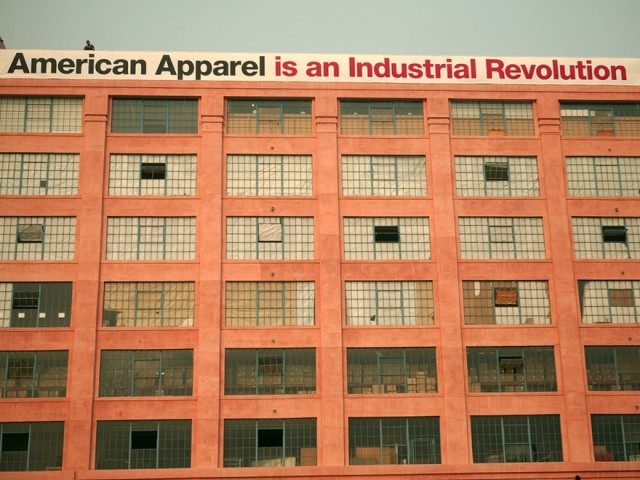The first accomplishment of California’s pioneering $15 minimum wage law is killing the revival of America’s clothing industry.
American Apparel, which provided 10 percent of all apparel manufacturing jobs in Los Angeles, has terminated 500 employees in the last two weeks. Chief Executive Paula Schneider also told the Los Angeles Times that “manufacturing of more complicated pieces, such as jeans, could soon be outsourced to a third-party company.”
The company did not tie the announcement directly to California Governor Jerry Brown signing of the nation’s first statewide $15 minimum wage on April 4. But the layoffs started shortly almost immediately after Brown’s action, and were announced on April 14 as labor organizers filled Los Angeles streets with fast-food workers set to strike, supported by unionized home-care and child-care workers.
Lloyd Greif, Chief Executive of Los Angeles investment banking firm Greif & Co. told LA Times, “They’re headed out of Dodge.” He added, “They are going to outsource all garments. It’s only a matter of time.”
At the turn of the 21st Century, Los Angeles County was the “rag trade” capital of America. With 4,000 active apparel-making sites employing almost 90,000 workers, the Los Angeles area was over twice the size of the rag trade in the New York region.
Apparel-making got cut in half over the next decade, as Chinese and Asian imports coming through Los Angeles ports sky-rocketed to $46 billion. The number of local apparel-making sites fell to 2,200 and local industry jobs shriveled to 46,000.
But according to the California Fashion Association, Los Angeles apparel-making was back to growth by 2013 as a “steady inflation rate” in China, driven by higher labor costs, increasingly pushed apparel manufacturing and textile contractors to move to lower wage countries like Vietnam, Cambodia, and Bangladesh. Coupled with high sea, land, and air shipping costs, the advantage in outsourcing apparel-making versus U.S. manufacturing became much less attractive.
Last year in Los Angeles County, there were 62,774 workers in apparel-making and 10,887 workers in textile manufacturing. Although imports were still substantial, local companies booked revenues of over $18 billion and paid workers $6.4 billion. Average rate of pay for fashion designers was $35-per-hour, and the average pay for apparel and textile workers hit $15-per-hour.
By capturing 36 percent of all U.S. apparel manufacturing, the Los Angeles County fashion ethosphere also supported 3,770 fashion designers, 5,590 cosmetics workers, 6,985 jewelry workers and 5,904 footwear workers.
Cheered by union workers — some chanting in Spanish — at Brown’s Los Angeles signing ceremony for the bill lifting the statewide minimum wage to $15 an hour by 2022, the governor all but admitted he was terminating the competitiveness of the Los Angeles rag trade and tanking the growing workforce with the comment, “Economically, minimum wages may not make sense.”
Brown rationalized his action’s brutal consequences by stating, “But morally and socially and politically they make every sense, because it binds the community together and makes sure that parents can take care of their kids in a much more satisfactory way.”

COMMENTS
Please let us know if you're having issues with commenting.